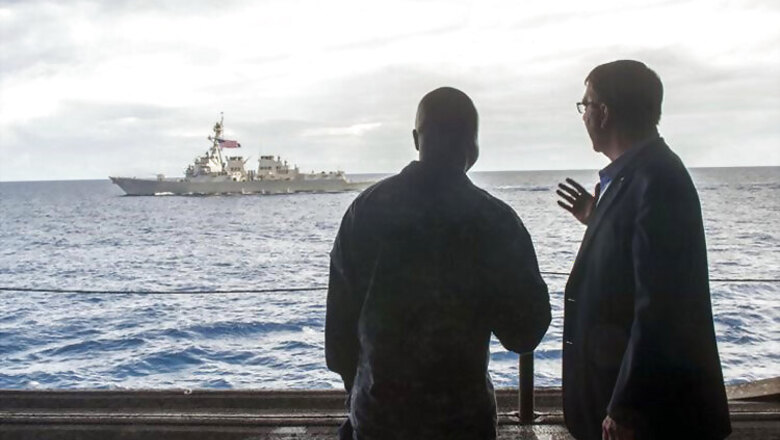
views
Onboard the USS Theodore Roosevelt, South China Sea: As soon as the guided-missile destroyer USS Lassen breached 12-nautical-mile territorial limits around one of China's man-made islands in the disputed South China Sea last week, a Chinese warship shadowing its movements began demanding answers.
"'Hey, you are in Chinese waters. What is your intention?'," it asked, as recounted to reporters on Thursday by Commander Robert Francis, commanding officer of the Lassen.
His crew replied that they were operating in accordance with international law, and intended to transit past the island, carrying out what US officials have called a freedom-of-navigation exercise designed to challenge China's claims to the strategic waterway.
The response from the Chinese destroyer?
"The same query, over and over," said Francis, speaking onboard the aircraft carrier USS Theodore Roosevelt as it sailed 150 to 200 nautical miles from the southern tip of the Spratly archipelago, a chain of contested islands where China's seven artificial outposts have taken shape in barely two years.
The Lassen had joined the carrier strike group the night before, ahead of a visit to the Theodore Roosevelt by US Secretary of Defense Ash Carter, who while on board blamed China for rising tension in the region.
Beijing has rebuked Washington over the Lassen's patrol, the most significant U.S. challenge yet to territorial limits China claims around its new islands.
China claims most of the South China Sea, through which more than $5 trillion in global trade passes every year. Vietnam, Malaysia, Brunei, the Philippines and Taiwan have rival claims.
In comments that underscore the frequency with which U.S. warships now come across Chinese vessels in Asian waters, Francis said the Lassen had had about 50 "interactions" with Chinese military ships and aircraft since May while on patrol in the South and East China Seas, something he described as routine.
"Every day a US ship is down here, we interact with the Chinese," Francis said.
Experts say China has dozens of naval and coastguard vessels deployed in the South China Sea at any given time, adding that encounters with US warships are likely to increase after US officials said the navy planned to conduct patrols within 12 nautical miles of China's artificial islands about twice a quarter.
"What are you guys doing this Saturday?"
The Chinese destroyer shadowed the Lassen for 10 days before and after its October 27 patrol near the artificial islands, said Francis. The Lassen got to within six to seven nautical miles from the nearest Chinese land formation, he added.
But not all US-Chinese naval interactions are tense, especially when things are slow on the high seas.
"A few weeks ago we were talking to one of the ships that was accompanying us, a Chinese vessel ... (We) picked up the phone and just talked to him like, 'Hey, what are you guys doing this Saturday? Oh, we got pizza and wings. What are you guys eating? Oh, we're doing this. Hey, we're planning for Halloween as well'." The intent, Francis said, is "to show them ... that we're normal sailors, just like them, have families, just like them."
The Chinese sailors, speaking in English, responded by talking about where they were from, their families and places they have visited, Francis said.
Eventually, the Chinese destroyer that had followed the Lassen on its mission past the artificial islands peeled away.
"They were very cordial the entire time ... even before and after the Spratly islands transit," Francis said.
"When they left us they said, 'Hey, we're not going to be with you anymore. Wish you a pleasant voyage. Hope to see you again'." As for Francis and his crew of 300 sailors, they were unfazed by the intense media coverage of one of the most highly anticipated US naval patrols in years, although Francis said his mother, having seen the news, did call to ask whether he was actually in China.
"It's another day in the South China Sea. All of it is professional," he said.

















Comments
0 comment